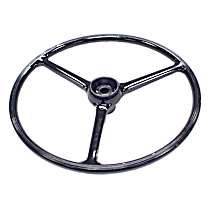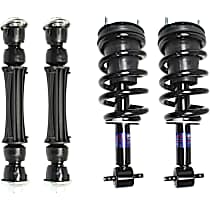The steering wheel vibrates at certain speeds, usually between 50 and 70 miles per hour.
This is usually caused by a front wheel out of balance. If you feel the vibration only in your seat, it’s probably a rear wheel. In either case it pays to have all 4 wheels balanced at the same time. You will be surprised at the difference it will make in the way the car will ride.
My car drifts to the left or to the right when I let go of the steering wheel on a straight and level road.
First, check the air pressure in all your tires, then try driving it again. If your car drifts to the right in the right lane and to the left in the left lane, it is probably normal. Most roads are banked to allow for water runoff. Make sure both front tires are the same size, type and brand. If not, take both front tires and switch them side to side. If the car now drifts in the opposite direction, you’ve found your problem. If the problem is still there, you should have the wheel alignment checked. However, bear in mind that while some cars have adjustments to correct pulling problems, most modern front wheel drive cars do not. If that’s the case your mechanic should check for bent or worn front end parts that can cause this condition and ascertain whether there are any safety concerns.

When I drive down a straight road, the spokes of my steering wheel are not centered.
This is also a wheel alignment problem, but one that is easy to correct by doing a wheel alignment. However, make sure the mechanic checks for worn or damaged parts. If the problem appeared suddenly, possibly after you hit a pot-hole or curb or something like that, then you’ve most likely have sustained some damage which should be checked as soon as possible to avoid serious tire wear.
There is a humming noise coming from my tires on a smooth road.
If you have a front wheel drive car and you haven’t rotated your tires in a while, check the rear tires. Run your hand around the edge of the tread, first in one direction, then the other (Note: be careful not to injure yourself on debris or exposed steel belts on the tire). You are looking for a “saw-tooth” wear pattern between the tread blocks. If the tread is smooth in one direction but jagged in the other direction, you may have found some of the noise. Try rotating the tires using the car manufacturers recommended procedure. You want to make sure that the rear tires are crossed over to the other side of the car and placed on the front. This wear pattern is common on front wheel drive cars with tires that are designed with grooves on the edges of the tread. While there is a potential for noise with this design, it does have advantages in wet weather and snow.

When I drive over a speed bump or a dip in the road, my car bounces 2 or more times before settling down.
This condition is usually caused by worn or broken shocks or struts. This condition happens gradually over the life of the shocks and it is hard to notice the change, but when they are replaced you should notice a big difference in the ride and stability of your car.
My directional signals flash on one side but not the other.
This is a designed in feature of most directional signal systems to let you know that a directional bulb has burnt out on the side that is not flashing. The best way to check them is to put on your 4-way flashers which usually use the same bulbs as the directionals and look for the bulb that is not flashing. If all the bulbs are flashing, then there is probably a bad bulb socket or ground causing excessive resistance. Some mechanics will simply replace the flasher with a “heavy-duty” flasher to correct this problem and get the directionals flashing again. But all that accomplishes is to disable the designed-in warning system of the original flasher and mask the problem of the bad socket or ground.
Where to Get Brakes, Suspensions, and Steering Components
Damage in the brake system, suspensions, and steering components add to a pretty hefty bill. Thankfully, you can save more by getting replacement pieces with CarParts.com before you aggravate the damage.
Why scour auto parts shops for brake, suspension, and steering part components when you can shop online here at CarParts.com? Enter your daily driver’s year, make, and model into the selector, then use the filters to find compatible parts that fit your needs. Find what you need and check out securely in minutes.
We source our products from the most trusted industry manufacturers to ensure you get parts that last. Our warehouses are strategically located throughout the country, so expect your order in a few days.
Do you have questions? Our friendly customer service team is ready 24/7 to assist you. Shop for steering or suspension system parts online, and get the best value for your money!
Products Mentioned in this Guide
Any information provided on this Website is for informational purposes only and is not intended to replace consultation with a professional mechanic. The accuracy and timeliness of the information may change from the time of publication.


 Steering Wheel
Steering Wheel
 Shock Absorber And Strut Assembly
Shock Absorber And Strut Assembly
















